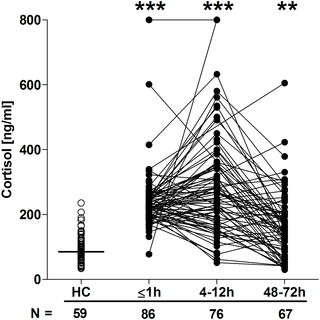PLOS Medicine ( IF 10.5 ) Pub Date : 2017-07-18 , DOI: 10.1371/journal.pmed.1002338 Jon Hazeldine , David N. Naumann , Emma Toman , David Davies , Jonathan R. B. Bishop , Zhangjie Su , Peter Hampson , Robert J. Dinsdale , Nicholas Crombie , Niharika Arora Duggal , Paul Harrison , Antonio Belli , Janet M. Lord

|
Background
Almost all studies that have investigated the immune response to trauma have analysed blood samples acquired post-hospital admission. Thus, we know little of the immune status of patients in the immediate postinjury phase and how this might influence patient outcomes. The objective of this study was therefore to comprehensively assess the ultra-early, within 1-hour, immune response to trauma and perform an exploratory analysis of its relationship with the development of multiple organ dysfunction syndrome (MODS).
Methods and findings
The immune and inflammatory response to trauma was analysed in 89 adult trauma patients (mean age 41 years, range 18–90 years, 75 males) with a mean injury severity score (ISS) of 24 (range 9–66), from whom blood samples were acquired within 1 hour of injury (mean time to sample 42 minutes, range 17–60 minutes). Within minutes of trauma, a comprehensive leukocytosis, elevated serum pro- and anti-inflammatory cytokines, and evidence of innate cell activation that included neutrophil extracellular trap generation and elevated surface expression of toll-like receptor 2 and CD11b on monocytes and neutrophils, respectively, were observed. Features consistent with immune compromise were also detected, notably elevated numbers of immune suppressive CD16BRIGHT CD62LDIM neutrophils (82.07 x 106/l ± 18.94 control versus 1,092 x 106/l ± 165 trauma, p < 0.0005) and CD14+HLA-DRlow/− monocytes (34.96 x 106/l ± 4.48 control versus 95.72 x 106/l ± 8.0 trauma, p < 0.05) and reduced leukocyte cytokine secretion in response to lipopolysaccharide stimulation. Exploratory analysis via binary logistic regression found a potential association between absolute natural killer T (NKT) cell numbers and the subsequent development of MODS. Study limitations include the relatively small sample size and the absence of data relating to adaptive immune cell function.
Conclusions
Our study highlighted the dynamic and complex nature of the immune response to trauma, with immune alterations consistent with both activation and suppression evident within 1 hour of injury. The relationship of these changes, especially in NKT cell numbers, to patient outcomes such as MODS warrants further investigation.
中文翻译:

创伤前的院前免疫反应与多器官功能障碍综合征的发展:一项前瞻性队列研究
背景
几乎所有研究对创伤的免疫反应的研究都分析了入院后采集的血液样本。因此,我们对受伤后即刻阶段患者的免疫状态以及这可能如何影响患者预后的了解甚少。因此,本研究的目的是全面评估创伤后1小时内的超早期免疫反应,并对其与多器官功能障碍综合症(MODS)的关系进行探索性分析。
方法和发现
分析了89名成年创伤患者(平均年龄41岁,年龄范围18-90岁,男性75位)对创伤的免疫和炎症反应,平均损伤严重程度评分(ISS)为24(范围9-66),其中血液在受伤后1小时内采集样本(平均采样时间为42分钟,范围为17-60分钟)。在创伤的几分钟内,全面的白细胞增多,血清促炎和抗炎细胞因子升高,以及先天细胞活化的证据,包括中性粒细胞胞外陷阱的产生以及Toll样受体2和CD11b在单核细胞和中性粒细胞上的表面表达分别升高,被观察。还检测到与免疫受损相一致的特征,尤其是免疫抑制性CD16 BRIGHT CD62L DIM中性粒细胞数量增加(82.07 x 106 / l±18.94对照vs 1,092 x 10 6 / l±165创伤,p <0.0005)和CD14 + HLA-DR低/-单核细胞(34.96 x 10 6 / l±4.48对照vs 95.72 x 10 6 / l±8.0创伤,p <0.05),并降低了对脂多糖刺激的白细胞细胞因子分泌。通过二元logistic回归进行的探索性分析发现,绝对自然杀伤T(NKT)细胞数与MODS的后续发展之间存在潜在的联系。研究局限性包括相对较小的样本量和缺乏与适应性免疫细胞功能有关的数据。
结论
我们的研究强调了对创伤的免疫反应的动态和复杂性,在损伤后1小时内,免疫变化与激活和抑制相一致。这些变化(尤其是NKT细胞数量)与患者预后(例如MODS)之间的关系值得进一步研究。









































 京公网安备 11010802027423号
京公网安备 11010802027423号